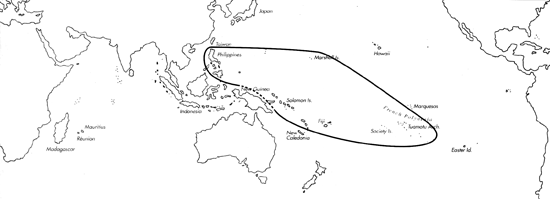
Skip Navigation Links
View access keys for this site.

Range: Tuamotu Archipelago, Society and Marshall Is., Philippines, Vanuatu and Solomon Is.
Description: Moderately large to large, moderately solid to solid; relative weight of similarly sized specimens may vary by 40%. Last whorl narrowly ovate or narrowly cylindrical to ovate or cylindrical; outline slightly convex or straight and parallel- sided at adapical two-thirds; left side variably concave at basal fourth to third. Aperture wider at base than near shoulder. Shoulder indistinct. Spire of moderate height, outline straight. Teleoconch sutural ramps flat to slightly convex, with 1-2 spiral grooves grading into numerous spiral striae. Last whorl with closely spaced weak spiral ribs at base and weak spiral threads above.
| Shell Morphometry | ||
|---|---|---|
| L | 55-102 mm | |
| RW | 0.12-0.35 g/mm | |
| (L 55-90 mm) | ||
| RD | 0.40-0.55 | |
| PMD | 0.56-0.65 | |
| RSH | 0.14-0.18 | |
Ground colour white, usually suffused with pink. Last whorl overlaid with brown to reddish brown, leaving small to moderately large ground-colour tents. Brown areas interspersed with spiral rows of alternating darker brown dots or dashes and very small ground-colour markings. Larval whorls and about first 4 postnuclear sutural ramps immaculate white. Late ramps with connected radial blotches, streaks and lines matching last whorl pattern in colour. Aperture white, usually pale pink or yellow deep within.
Periostracum yellow, thin, translucent, smooth.
Dorsum of foot white, radially maculated with connected brown blotches and veins, darker marginally; anterior end light brown, with a median black blotch. Sole of foot white, with reticulated brown blotches and veins. Rostrum white, heavily mottled with brown except for the distal edge. Proboscis light orange, grading to orangish tan proximally. Tentacles white, tipped with brown. Siphon white, heavily mottled with brown, tipped with pink; a black transverse band located about 1/3 of the length from the tip (Pearson, unpubl. observ.).
Habitat and Habits: Shallow subtidal. In Marshall Is., C. auratinus in 13-18 m on lagoon pinnacles and at the ocean-side of coral reefs, in caves and coral rubble.
Discussion: C. auratinus had been considered a variety of C. aulicus by Sowerby I and was assigned to C. auricomus or referred to as C. auratus Hwass by subsequent authors. For the distinctions from C. auricomus, see the Discussion of the latter species. As C. auratus Hwass proved to be a synonym of C. aulicus (Kohn, 1968), da Motta redescribed C. aulicus var. roseus as C. auratinus. The shoulder of C. aulicus is more distinctly demarcated from the last whorl, its PMD is closer to the shoulder (0.63- 0.75), and the spiral sculpture is more prominent on both its last whorl and its early teleoconch sutural ramps. At localities where both species live together, no intermediate specimens have been found.

C. auratinus range map
This section contains verbatim reproductions of the accounts of 316 species of Conus from the Indo-Pacific region, from Manual of the Living Conidae, by Röckel, Korn and Kohn (1995). They are reproduced with the kind permission of the present publisher, Conchbooks.
All plates and figures referred to in the text are also in Röckel, Korn & Kohn, 1995. Manual of the Living Conidae Vol. 1: Indo-Pacific Region.
The range maps have been modified so that each species account has it own map, rather than one map that showed the ranges of several species in the original work. This was necessary because each species account is on a separate page on the website and not confined to the order of accounts in the book.
Return to framed version (returns to search page)